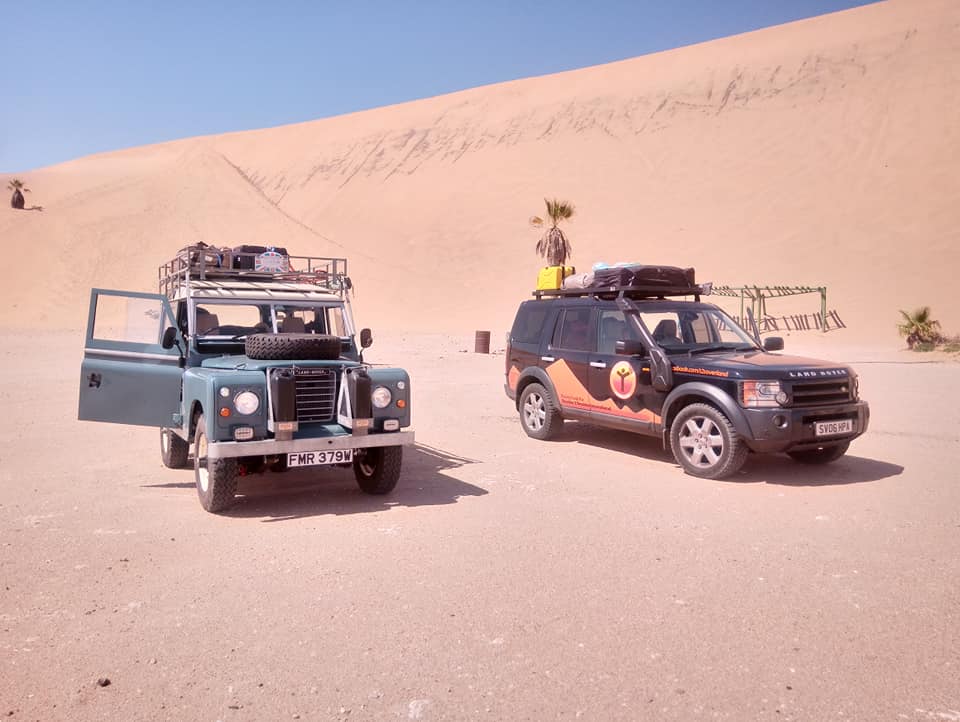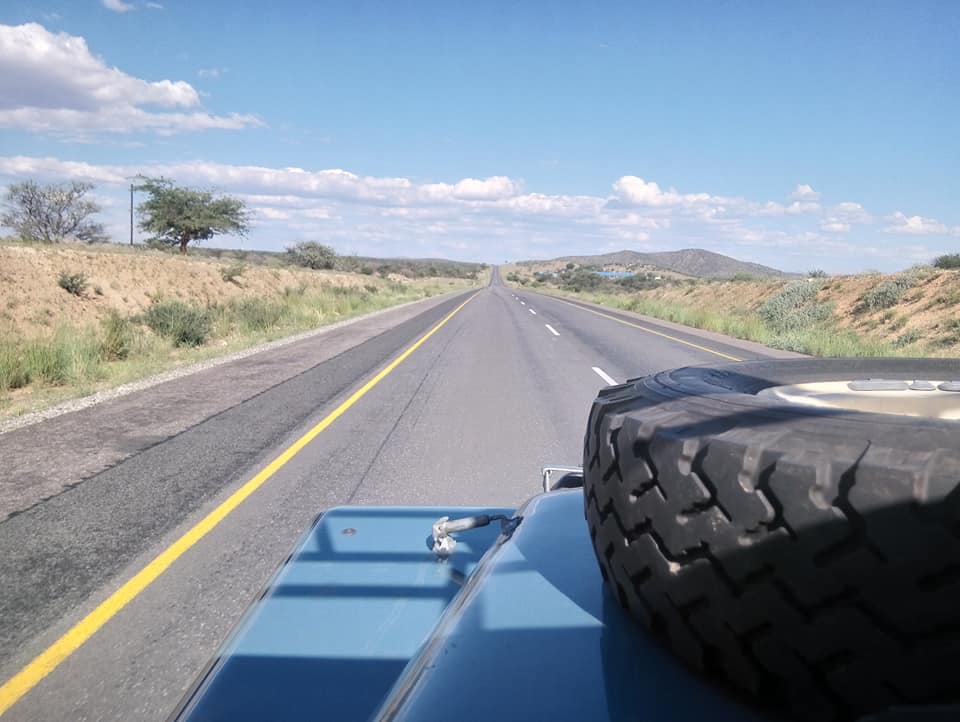It Gets In Your Blood
It’s unfortunate that I couldn’t update this blog any sooner, but we’ve had to come to Botswana to have internet good enough to upload to this blog. It’s such a shame!
I suppose I’d better start by reflecting on the last few days in Namibia before I talk about Botswana. Namibia is simply breath taking. If you thought the scenery in the UK was diverse then Namibia offers complete changes of environment, from desert plains and sand dunes to savannah and mountain ranges in little more than thirty minutes of driving. It’s a case of blink and you’ll miss it.

The roads in Namibia which we have travelled are really very good indeed, the tarmac ones at least. The gravel ones which are the backbone of the country’s road network can be perfectly smooth to horrendous corrugations, but the tarmac ones put Britain’s to shame. They are so smooth, so wide and so low in traffic volume, covering three hundred plus miles in a day is easy. That is, unless a vehicle decides to breakdown.
Day one on the road was beset by constant running problems which were down to a multitude of factors. This is going to get technical. If you don’t want the technical jargon, I’d skip the next few paragraphs because it’s really quite boring for most people. However, for some people like me, it’s a fascinating subject and if you’re shipping a car, particularly a petrol vehicle, from the UK to Africa, you need to be aware of it.
Unleaded fuel in Britain contains five percent ethanol, mainly because it’s required by the government and it’s supposed to be better for the environment. I’m all for protecting the environment and I believe every single one of us has a responsibility to do so. However, like all things it has a downside, and this one seldom affects motorists in the UK but does if a vehicle is sitting for a few weeks or so.
Over time, the ethanol separates from the petrol itself, forming an acidic water that attacks fuel lines, rubber components and generally causes fuel to “go off” for want of a better word far more quickly than it would if it didn’t contain ethanol. This acidic water sits below the fuel in the tank, simply because water is denser than either petrol or diesel. Not only does this cause corrosion, but vehicles don’t like running on water.
This, in my case, was exacerbated by the fact that I filled up in freezing cold United Kingdom, it sat in a steel container for six weeks, and the fuel tank on the Series III is steel. All of this creates a perfect breeding ground for condensation, and so what ordinarily would have been about five percent water in the fuel after this length of time, became more like forty percent. The Discovery, having a plastic fuel tank and effective water separation systems from new in the fuel system, was unaffected.
The big problem with this is that the fuel pick up pipe in nearly all vehicles (including mine) is at the very bottom of the fuel tank, and so effectively it was trying to run on a mixture of fuel and water. This, and dirt in the fuel caused the vehicle to completely stop after about ninety minutes of driving. Because the fuel pump would no longer work, we had to replace it with a new one.
Anyway, about an hour later, the running problems came back, this time it was misfiring, juddering and generally had no power. At one point thirty five miles per hour was our new top speed, which when you’ve got maniacal African truck drivers behind you is not a good thing to have. We were utterly convinced that it was the fuel that was causing it, so we switched to my auxiliary fuel tank. Whilst it now did forty five miles per hour flat out, the other issues remained.
We were utterly flummoxed by this, so we spent the following five hours chugging along watching Namibia’s breath taking scenery go by. After leaving at just after eight o’clock in the morning, we’d finally got to the capital Windhoek at about six-thirty in the evening, having covered just over three hundred miles, two hundred and fifty of those probably the hardest I’ve ever done in my life.
Windhoek is really just like any city in the world, except this one sits in a natural bowl surrounded by mountains that climb to well over seven thousand feet above sea level. Just walking back from a restaurant at this altitude of around six thousand five hundred feet can leave you a little bit breathless. This means that Windhoek is very hilly indeed, but actually a very beautiful place. What’s mesmerising about it all though is how the main road past the airport and to Botswana climbs these mountains.

The road is extremely steep yet incredibly fast with a speed limit of one hundred and twenty kilometres per hour (about seventy five miles per hour), that is unless you’re behind a misbehaving old Land Rover that at this altitude and with ever worsening running problems would hardly go faster than thirty miles per hour!

Cue breakdown number two, a major oil leak. We have a gasket set which has most of the gaskets on the engine, except this one! Completely stuck as to how to fix it, my mother in one of her moments of wisdom suggested making a gasket out of a cereal box. Apparently, it’s not the first time she’s done it, but anyway over five hundred miles later it has worked really well!
At the end of day two we stopped at East Gate Lodge, literally about quarter of a mile from the border with Botswana. It’s a pleasant place but the drive down to it was something else. Coming down from the plateau you descend around two thousand feet, you can see for miles right into Botswana; all you can see for miles and miles are trees. It’s amazing how quickly the scenery can change in Namibia.

Crossing the border the following day was fairly pain-free, and we all made it without issue, even if the border guards were slightly confused by having two different types of UK number plate systems on the go! Even so, within forty five minutes we were cleared and on the go again.
Botswana’s roads are pretty much totally unfenced and so wild animals can cross at any time. Within twenty minutes of crossing the border, I, in the lead vehicle, had my first encounter as some goats decided that now was the perfect time to cross the road. It was pretty hairy stopping from fifty-five miles per hour to a complete standstill in a hurry, with a fully loaded vehicle using braking technology from the nineteen fifties!

Still, it was not as hairy as what happened a few miles later, when I was overtaking a pick-up truck. As I had nearly passed the truck a donkey decided, at the very last second, to wonder into the road. Amazingly, I just stopped in time, as did the pick-up I was overtaking. The Discovery also had to slam its brakes on, as it was overtaking also. We nearly had a three-car pile-up all because of a donkey!
Anyway, the road from Ghanzi to Maun was a pretty mind-numbingly boring one. All you could see either side of this perfectly straight road was a bit of grass and trees for about two hundred miles. I’m glad that we had to stop for fuel at Sehithwa (admittedly the fuel looked rather disgusting in colour… I’m so glad we had our Mr Funnel filters), and I am also very glad that we had veterinary fences to slow down for. That and the animal encounters broke up a rather tedious journey.

The Old Bridge Backpackers at Maun is a strange old place, but one I’d definitely come to again. It is, admittedly, rather touristy but it also seems to be a magnet for the locals. It serves good food, and has a rather laid back atmosphere. It’s also where I met Laura Morrison, a New Zealander who now lives in Maun, who drove her Morris Minor all the way from Aberdeen in Scotland, all the way to Cape Town in South Africa. You can read her story by visiting www.morri2africa.com. We also bumped into two women from Plymouth who are halfway through their world trip. It is always nice to hear other people’s experiences and stories, and be able to compare them with your own. I’m glad I have met these people because they’re all lovely and I really hope to keep in contact with them in the future.

So our plans for the next few days are to stop at Elephant Sands near Nata (as recommended by Laura Morrison) and then make our way into Zambia. I probably won’t be able to blog until then but even so, I hope you’ve enjoyed reading this one!
4 Responses
Hello there Cameron, great to read your blog with the details of the mechanical challenges you faced in the early stages of your journey and how you were able to solve them. You do indeed write very well and I can see your blog entries will be a big stepping stone in publishing a book for this great adventure. All the best from Jan & Alec.
Writing a book is something I would like to do one day. I will have to expand a lot more on the blog entries and cover all of the details like you did in your book. Thank you though!
Hallo Camron, we are so pleased that your dream is realty. It is amazing to read all the challenges you are taken because of love for need children. We wishes you protection, good health and enjoy the sun. Send some sun, Netherlands s too cold for us.?? Thank you
Joseph Matheka &Ria
Apparently it’s cold in the UK as well! We’ve been getting a lot of rain recently though, which has made the roads in Zambia rather difficult!